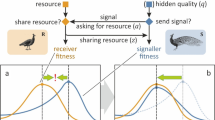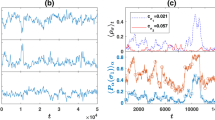Abstract
The handicap principle (HP) stipulates that signal reliability can be maintained if signals are costly to produce. Yet empirical biologists are typically unable to directly measure evolutionary costs, and instead appeal to expenditure (the time, energy and resources associated with signaling behavior) as a sensible proxy. However the link between expenditure and cost is not always as straightforward as proponents of HP assume. We consider signaling interactions where whether the expenditure associated with signaling is converted into an evolutionary cost is in some sense dependent on the behavior of the intended recipient of the signal. We illustrate this with a few empirical examples and demonstrate that on this alternative expenditure to cost mapping the traditional predictions of HP no longer hold. Instead of full information transfer, a partially informative communication system like those uncovered by Wagner (Games 4(2):163–181, 2013) and Zollman et al. (Proc R Soc B 20121878, 2012) is possible.






Similar content being viewed by others
Notes
We follow the animal communications literature here and use the phrase ‘honest communication’ to refer to the scenario in which receivers can reliably infer the unobservable feature of interest based on the sender’s signaling behavior. In general, the notion of reliability, honesty and deception is a tricky matter when dealing with non-intention based communication. We do not address these issues in the course of this paper.
This basic story can easily be generalized to more complicated cases in which, for instance, there are a continuum of sender types. See Grafen (1990) for instance.
Of course this is not a vindication of HP for it must be further shown that the costs are differential—i.e., that low-quality males displaying the signal incur a higher fitness penalty than high-quality males.
In addition to vulnerability signals, so-called retaliatory signals or retaliatory handicaps are also examples of a receiver-dependent signal. See Molles and Vehrencamp (2001).
In general, those working in animal communication tend to ignore vulnerability signals. We think they are a bit more prevalent than previously thought (as evidenced by the examples provided in this section) and think they also highlight important assumptions typically made at the core of costly signaling theory (such as the assumed straight-forward relationship between expenditure and cost).
Brandt (2003) found endurance of lizards fell below baseline levels immediately after a signaling display, meaning the display is in fact hampering the lizard’s ability to effectively fend off predators.
It is worth noting here that we do not have any definitive proof that the push display on its own is not costly. From all descriptions of the display we’ve encountered in the literature, however, we feel safe asserting that the production of the signal alone does not reduce the fitness of the sender.
Note that as has been acknowledged in the literature, expenditure is not the only means of placing individuals in a vulnerable position. Consider the predator–prey signal sent by the guppy poecilia reticulate, often referred to as a ‘predator approach’ signal. In this case the guppy, upon spotting a predator, moves toward the predator. This behavior is taken in the literature as communicative and can be seen as an instance of a vulnerability signal (that does not involve any expenditure).
Calling signals that are costly regardless of the response of the intended recipient of the signal ‘intrinsic’ is a bit of a misnomer because the cost associated with signalling could be due to a third-party eavesdropper (in which case costs are neither intrinsic to the sender, nor due to the response of the intended recipient).
Parameter values were selected randomly via the following procedure. The value of c l was determined by a draw from the uniform distribution on the unit interval. \(c_{h}^{v}\) was the determined by a draw from the uniform distribution spanning from zero to the value of \(c_{l}^{v}\). The probability senders are high-types was determined by a draw from the uniform distribution spanning from zero to 0.5.
See for instance, chapter 5 (‘The evolution of signal form’) in Maynard-Smith and Harper (2003).
We think this is a somewhat reasonable starting assumption since we know of no case in which both intrinsically costly signals and vulnerability signals are utilized in the same strategic context.
A formal model investigating when certain types of signals will be taken up is mathematically challenging and thus will not be explored in the course of this paper.
We compare the vulnerability hybrid to the separating equilibrium and not the intrinsically costly hybrid equilibrium because both sender and receiver do better at the separating equilibrium than at the intrinsically costly hybrid.
It is clear that the traditional separating equilibrium could be more likely to emerge (i.e., have a larger basin of attraction) than the vulnerability hybrid equilibrium despite the fact that both parties prefer the vulnerability hybrid to the separating equilibrium. For instance, in the so-called Stag Hunt game, all prefer the stag hunting equilibrium to the hare hunting equilibrium, yet the hare hunting equilibrium is more likely under the replicator dynamics due to the inherent risk attached to hunting stag (see Skyrms 2004 for more on this point).
Kane and Zollman (2015) construct a model to investigate when different types of signals will go to fixation, but do not consider the vulnerability signals we’ve addressed in this paper. Holman (2012) considers a similar question in a slightly different mathematical framework and Huttegger, Bruner and Zollman (2015) explore ‘hybrid’ signals—signals which have properties common to two or more traditional signal types (for instance, signals that are both intrinsically costly and result in the sender being placed in a vulnerable position).
In particular, when the receiver responds to the signal by treating the sender as a high-type, (2) and (3) will hold. It is clear that (1) will always hold since all high-types signal but only a fraction of low-types signal, meaning the probability of a high-type conditional on receipt of the signal is greater than the unconditional probability of the sender being a high-type (which must hold if (1) is to be satisfied).
References
Adams E, Mesterton-Gibson M (1995) The cost of threat displays and the stability of deceptive communication. J Theor Biol 175(4):405–421
Bennett A, Huey R (1990) Studying the evolution of physiological performance. Oxf Surv Evolut Biol 7:251–284
Bicchieri C, Duffy J (1997) Corruption cycles. Polit Stud 45(3):477–495
Brandt Y (2003) Lizard threat display handicaps endurance. Proc R Soc B 270(1519):1061–1068
Bruner J (2013) Policing epistemic communities. Episteme 10(4):403–416
Dawkins R, Krebs JR (1979) Arms races between and within species. Proc R Soc Lond Biol Soc 205(1161):489–511
Enquist M, Plane E, Roed J (1985) Aggressive Communication in fulmars (Folmarus glacialis) competing for good. Anim Behav 33:1007–1020
Fraser B (2012) Costly signaling theories: beyond the handicap principle. Biol Philos 27:263–278
Grafen A (1990) Biological signals as handicaps. J Theor Biol 144(4):517–546
Hofbauer J, Sigmund K (1998) Evolutionary games and population dynamics. Cambridge University Press.
Holman L (2012) Costs and constraints conspire to produce honest signaling: insights from an ant queen pheromone. Evolution 66(7):2094–2105
Huttegger S, Zollman K (2010) Dynamic stability and basins of attraction in the Sir Philip Sidney game. Proc R Soc B 277:1915–1922
Huttegger S, Zollman K (2013) Methodology in biological game theory. Br J Philos Sci 64(3):637–658
Huttegger S, Bruner J, Zollman K (2015) The handicap principle is an artifact. Philos Sci 82(5):997–1009
Kane P, Zollman K (2015) An evolutionary comparison of the handicap principle and hybrid equilibrium theories of signaling. PloS ONE 10(9):e0137271
Kotiaho J (2000) Testing the assumptions of conditional handicap theory: costs and condition dependence of a sexually selected trait. Behav Ecol Sociobiol 48(3):188–194
Kotiaho J (2001) Costs of sexual traits: a mismatch between theoretical considerations and empirical evidence. Biol Rev 76(3):365–376
Lachmann M, Szamado S, Bergstrom C (2001) Cost and conflict in animal signals and human language. Proc Natl Acad Sci USA 98(23):13189–13194
Leal M (1999) Honst Signaling during prey-predator interactions in the lizard Anolis cristatellus. Anim Behav 58:521–526
Martinez M (2015) Deception in sender–receiver games. Erkenntnis 80:215–227
Maynard-Smith J, Harper D (2003) Animal signals. Oxford University Press, Oxford
McWhirter G (2015) Behavioral deception in formal models of communication. Br J Philos Sci. doi:10.1093/bjps/axv001
Moeller A, De Lope F (1994) Differential costs of a secondary sexual character: an experimental test of the handicap principle. Evolution 48:1676–1683
Molles L, Vehrencamp S (2001) Songbird cheaters pay a retaliation cost: evidence for auditory conventional signals. Proc R Soc Lond B Biol Sci 268(1480):2013–2019
Pretwich K (1994) The energetics of acoustic signaling in anurans and insects. Am Zool 34:625–643
Ryan M (1988) Energy, calling, and selectin. Am Zool 28:885–898
Searcy W, Nowicki S (2005) The evolution of animal communication: reliability and deception in signaling systems. Princeton University Press, Princeton
Skyrms B (2004) The stag hunt and the evolution of social structure. Cambridge University Press
Skyrms B (2010) Signals: evolution, learning and information. Oxford University Press, Oxford
Waas J (1991a) Do little blue penguins signal their intentions during aggressive interactions with strangers? Anim Behav 41(3):375–382
Waas J (1991b) The risks and benefits of signaling aggressive motivation: a study of cave-dwelling little blue penguins. Behav Ecol Sociobiol 29(2):139–146
Wagner E (2013) The dynamics of costly signaling. Games 4(2):163–181
Weibull J (1995) Evolutionary game theory. MIT Press, Cambridge
Zahavi A (1975) Mate selection—a selection for a handicap. J Theor Biol 53(1):205–214
Zollman K (2012) Finding alternatives to handicap theory. Biol Theory 8(2):127–132
Zollman KJS, Bergstrom CT, Huttegger SM (2012) Between cheap and costly signals: the evolution of partially honest communication. Proc R Soc B doi:10.1098/rspb.2012.1878
Acknowledgements
We thank Kim Sterelny, Brian Skyrms, Simon Huttegger, Elliott Wagner, Hannah Rubin and audiences at the Sydney-ANU Philosophy of Biology Workshop, the Social Dynamics seminar at UC Irvine and the 2015 meeting of the International Society for the History, Philosophy and Social Studies of Biology.
Author information
Authors and Affiliations
Corresponding author
Appendix
Appendix
In this brief appendix we establish the evolutionary significance of the hybrid equilibrium. We begin by first considering a game consisting of just those strategies involved in the hybrid equilibrium. The payoff matrix for the sender, and receiver, are listed below.
We alter both matrices by subtracting different constants from each column. This results in the following (equivalent) game:
Under certain parameter values, there exists a mixed Nash equilibrium that corresponds to the hybrid equilibrium. We now attempt to determine the stability of the hybrid equilibrium under the replicator dynamics. Hofbauer and Sigmund (1998) prove that for there to be closed orbits around an equilibrium in the two-population replicator dynamics, two things most hold. First, all non-zero entries in S’ must be of the same sign, and, likewise, all non-zero entries in R’ must be of the same sign. Secondly, non-zero entries in S’ must be of the same sign as the non-zero entries in R’. Clearly, the non-zero entries in S’ are all positive, since p is a probability restricted between zero and one. The non-zero entries in R’ are all negative when x < .5. Yet recall that the hybrid equilibrium only exists when x < .5, meaning that whenever the hybrid exists there are closed orbits circling the equilibrium on the plane consisting of all four strategies involved in the hybrid equilibrium.
What of states that are not on this plane? Will they head to the plane and begin cycling around the hybrid? To determine this we examine small perturbations and consider how the remaining strategies would do when playing against the hybrid equilibrium. The payoff to senders at the hybrid equilibrium is:
The payoff to receivers at the hybrid equilibrium is: 1 − x. We now compare this to the payoff of the remaining two sender strategies (never send; send if low, do not send if high) against the hybrid. Both yield a payoff of zero, which is less than \(\frac{{x\left( {c_{h}^{v} - c_{l}^{v} } \right)}}{{1 + c_{h}^{v} }}\). The payoff of the remaining two receiver strategies (always classify as high; classify as high if no signal, low if signal) is p. Since a condition of the hybrid is that x < .5, it is clear that 1 – x > x, and thus whenever the hybrid does exist states near it will be pulled to the plane. Just as Zollman et al. conclude, the hybrid equilibrium in our model is strongly stable with respect to states not on the plane, and weakly stable with respect to states on the plane.
Rights and permissions
About this article
Cite this article
Bruner, J.P., Brusse, C. & Kalkman, D. Cost, expenditure and vulnerability. Biol Philos 32, 357–375 (2017). https://doi.org/10.1007/s10539-017-9563-5
Received:
Accepted:
Published:
Issue Date:
DOI: https://doi.org/10.1007/s10539-017-9563-5




